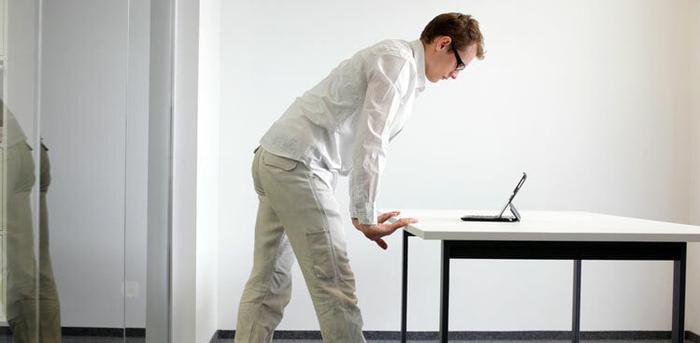
With so much research coming out about the hazards of sitting too much, it’s no surprise that standing desks are becoming all the rage.
Several of my friends have invested in standing desks over the past year or so, and I finally decided to see what all the hype was all about. So, last week, I took the challenge of standing instead of sitting at my desk. What did I learn over the course of seven days? Here are three main takeaways.
1. You Don’t Need a Fancy Standing Desk
I think the most important thing about joining the standing desk movement is understanding that it has less to do with the actual desk and more to do with standing and not sitting. Most people I know don’t have hundreds of dollars to spend on a new desk, after all.
So, what can you do? Create your own standing desk. In my case, this meant stacking some large books on top of each other on my normal desk, placing my laptop on top of those books, and pushing my chair to another part of my room so I wouldn’t be tempted to sit.
Want something a little more sophisticated (and stable) than a couple of books stacked on top of each other? You can create your own standing desk using cheap IKEA furniture or wooden workhorses.
The moral of the story? A lot of people think it’s not worth it unless you have a specially made standing desk, when really it’s all about just getting out of your chair.
2. Standing Can Lead to Wandering
I was super excited to be productive while standing up, but one thing I wasn’t prepared for? The desire to move around a lot once I was upright.
As soon as I started standing to do work, it became easy to wander mid-thought. I found myself walking over to my kitchen or schlepping around my room instead of focusing at my computer screen, which meant I was getting fewer things done than I would be if I were sitting. Until that moment, I hadn’t realized that one great thing about sitting is that you are, in fact, stationary (read: tied to your computer).
To keep myself from walking around all the time, I minimized the amount of work I was doing at home so that I wouldn’t be tempted to move around to a comfortable space. At an office or public space, you’re obviously way less likely to leave your computer alone (either due to accountability or just straight up security reasons).
But this is definitely an issue I’m still working on.
3. You Can’t Stand for the Entire Workday
Like any other form of exercise, standing for long periods of time is something you have to work up to and practice for weeks and months to get good at it. Don’t expect to be standing for eight hours straight like a champ on day one. I personally started feeling tired after about 30-40 minutes after forgoing my chair.
My advice: Come up with a standing-sitting schedule, then increase the standing you’re doing over time. I started out the week standing for 30 minutes and sitting for 15, and then repeating throughout the day. By the end of the week, I was starting to push that ratio to 40 minutes standing and 15 minutes sitting.
Upset that you’re not able to stand the entire length of the workday? I sure was. But just remember that every 40 minutes of standing you’re doing is 40 minutes of time you’re not sitting—and that’s so much better than a full eight hours in your chair. And who knows? Maybe a couple of months down the road, you’ll be standing for hours on end with no problem!
Overall, standing instead of sitting definitely had an impact on my work. I found myself feeling less fatigued over the course of the day, and I felt healthier even after only a week of testing this exercise out. Standing forces you to be alert in a way that sitting doesn’t, and, for me, that made the distractions caused by wandering worth it. Additionally, because I was more awake, I felt like the quality of work I was producing was much better. (No eyes glazing over at 3 PM!)
And besides, it was a great way to use all those books that I never actually have time to read.